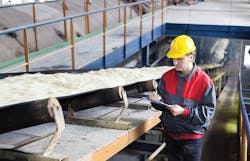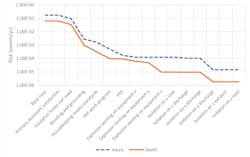Dust Hazard Analysis Beyond Prescriptive Measures
Due to the growing awareness of combustible dust hazards and broader adoption of regulatory requirements to complete a dust hazard analysis (DHA), manufacturing facilities are increasing efforts to implement hazard prevention and mitigation measures. Several statewide fire codes require facilities that produce or handle combustible particulate solids to conduct a DHA by Sept. 7, 2020 (per the 2019 Edition of NFPA 652, Standard on the Fundamentals of Combustible Dust).
The DHA aims to identify fire and deflagration hazards from combustible dusts handled or produced on site, identify gaps in compliance with codes and standards and determine solutions to reduce the risk associated with the identified hazards. It provides actionable, prioritized recommendations for risk mitigation and management. The goal is to reach an acceptable level of risk that protects worker safety, enables business continuity, and limits damage to the facility and the environment should an incident occur. A typical DHA involves material hazard analysis, building and process hazard analysis, and management system analysis.
Based on the facility requirements, budget and circumstances, the DHA can vary in complexity and depth of analysis—there are generally three options: prescriptive/compliance-based, performance-based and risk-based. The compliance-based DHA uses a checklist approach following the guidelines of applicable NFPA standards and is typically the quickest to implement with the lowest up-front cost. This approach identifies gaps in compliance with applicable standards and provides recommendations to close the gaps using the regulatory requirements. However, these gaps can be difficult to reconcile due to operational conflicts or the high capital cost of implementation.
In these cases, performance-based and risk-based approaches can be applied to ensure combustible dust hazards are mitigated consistent with the organization’s risk philosophy and capital budgets. The performance-based approach uses target performance criteria that, if shown to be met, would be an acceptable alternative to implementing prescriptive requirements (e.g., life safety and structural integrity objectives as identified in Section 6.3 of NFPA 652). On the other hand, the risk-based evaluation follows a similar approach but uses a risk assessment to determine acceptable fire/explosion protection measures (as outlined in Section 6.2 and 9.2.1 of NFPA 652). This approach requires an analysis of the likelihood or frequency of a fire/explosion and the severity of the consequences on personnel injuries/fatalities, structural integrity, and business continuity in the event of a fire or explosion incident.
The objective of these two approaches is to justify alternative means to meeting acceptable risk levels through the use of strategic and cost-effective preventative or mitigative measures based on the actual operating conditions of a facility.
As mentioned earlier, where a prescriptive DHA identifies gaps that are technically infeasible or require high capital investments (that could be unattainable), the performance-based or risk-based DHA should be considered. For example, if a multinational manufacturing corporation conducts enterprise-wide dust hazard analyses, a deficiency in explosion protection for similar vessels handling combustible dusts across all manufacturing plants might be identified.
Correcting these prescriptive deficiencies may be relatively easy on a small scale; however, “simple” upgrades replicated across several hundred facilities can require a vast capital investment. As a result, companies may not immediately implement safety measures, leaving personnel exposed to known hazards. For situations such as the one described above, an alternative approach could be applied to provide a means for selecting optimized risk-reduction measures to achieve industry accepted levels of risk.
Alternative Measures
In the following paragraphs, two cases are presented where alternative measures were employed to achieve an acceptable level of risk reduction in a cost-effective manner. One such case study is that of a manufacturing enterprise consisting of several facilities. A risk-based analysis was conducted for three combustible dust handling processes prevalent throughout several facilities (outdoor storage silos, centralized dust collection systems, and enclosureless dust collectors). The goal was to manage combustible dust hazards in accordance with the industry standard of care with the objectives of protecting life, property and business continuity.
As discussed, the NFPA standards on combustible dust outline options for meeting these objectives. Naturally, the prescriptive approach tends to be more conservative in such a case and its application to the systems in question would be required regardless of whether such measures contribute to an appreciable reduction in risk. In this case, the selected approach provided a method for selecting optimized risk-reduction measures to achieve industry accepted levels of risk.
The risk assessment methodology utilized fault tree analysis (FTA) and event tree analysis (ETA) to evaluate both components of risk (frequency of occurrence and severity of consequences). The cumulative effect on overall risk of personnel injury/fatality was determined for select safeguards that could be readily implemented at a facility (e.g., good housekeeping, ensure bonding and grounding, following a hot work program, etc.). An acceptable risk level was achieved for the facilities through implementation of select risk reduction measures: following strict housekeeping procedures, creating a hot work program and bonding and grounding the system. The incremental effect of each subsequent risk reduction measure is seen in Figure 1.
As shown in the figure, the measures that significantly reduced the risk of deaths/injuries due to a combustible dust explosion in the facilities were identified. This example demonstrates that the manufacturing enterprise could make substantial gains in reducing exposures consistent with industry risk tolerance thresholds without necessarily meeting all the prescriptive measures of the NFPA standards. The risk-based DHA methodology depends on factors such as availability and applicability of an organizational risk profile, facility conditions, and the planned budget for the DHA exercise. It is important to note that such a methodology would be specific to each facility/process and its use cannot be generalized for different facilities and organizations unless the process conditions are nearly identical.
Another example where an alternative approach was implemented was related to determining whether explosion protection is needed for indoor equipment handling combustible dusts at a manufacturing facility. The study looked at a facility served by two large dust collectors that were located indoors without any form of explosion protection. A prescriptive DHA was conducted and it indicated the indoor dust collectors likely presented a combustible dust explosion hazard and would require explosion protection and explosion isolation per NFPA 652 § 9.3.4 and 9.7.
Upon further evaluation, it was determined that a performance-based approach could be implemented to determine if existing conditions could meet the performance objectives for life safety, structural integrity, mission continuity, mitigation of fire spread and explosions, and effects of explosions. The equipment specifications and conditions in the dust collectors were further studied and the performance-based approach focused on determining whether a dust cloud in a combustible concentration could develop inside of the dust collectors. For the assessment, conditions during normal operations and upset conditions were evaluated to determine dust cloud concentrations and compare to minimum explosible concentration (MEC) of the material:
1. Normal operations: Determine average concentration of dust present in the equipment at any time by measuring total mass of collected material over a set time period and determine the average air flow rate.
2. Upset conditions: Consider effects of increased concentration in case of sudden dispersing of dust settled in ductwork, dislodgement of dust accumulated on walls of dust collector, or malfunction of pulse-air system resulting in dense dust cloud from material build-up on dust collector filters.
Note that the evaluation must take into account specific details of the equipment characteristics and operating conditions. In this case, the results indicated that for normal operations, dust concentration was less than three orders of magnitude below the MEC and did not reach MEC during any of the upset conditions evaluated. Therefore, it was possible to confirm that a combustible dust explosion could not occur within the dust collectors and therefore explosion protection was not necessary.
Using alternative approaches to a compliance-based DHA as discussed in this article, organizations can significantly reduce exposures consistent with industry risk tolerance thresholds without necessarily meeting all the prescriptive measures of the standards. This would allow facilities to implement selective, targeted and cost-effective risk reduction measures to reach a risk level that is considered broadly acceptable. In some cases where the base-line risk is already sufficiently low, such an approach may also illustrate that no further safeguards are necessary.
Kamal M. Aljazireh, PE, is a senior engineer with Jensen Hughes (www.jensenhughes.com), a safety, security and risk-based engineering and consulting firm, with a background in chemical, process safety, and fire protection engineering. His experience in industrial process safety consulting includes hazard analysis and evaluation, hazard mitigation techniques and requirements, code compliance studies, and specification of fire protection features for various industrial applications and hazardous materials.
Purvali Chaudhari, Ph.D, is a process safety consultant with Jensen Hughes with a focus on dust explosions, chemical process safety and machine learning modeling. Her experience in industrial consulting includes dust and process hazard analysis, fire hazard modeling and code compliance reviews.
References
“NFPA 652, Standard on the Fundamentals of Combustible Dust, 2019 Edition.” National Fire Protection Agency. Quincy, Mass. 2018.
About the Author
Kamal M. Aljazireh and Purvali Chaudhari
Kamal M. Aljazireh, PE, is a senior engineer with Jensen Hughes (www.jensenhughes.com), a safety, security and risk-based engineering and consulting firm, with a background in chemical, process safety, and fire protection engineering. His experience in industrial process safety consulting includes hazard analysis and evaluation, hazard mitigation techniques and requirements, code compliance studies, and specification of fire protection features for various industrial applications and hazardous materials.
Purvali Chaudhari, Ph.D, is a process safety consultant with Jensen Hughes with a focus on dust explosions, chemical process safety and machine learning modeling. Her experience in industrial consulting includes dust and process hazard analysis, fire hazard modeling and code compliance reviews.

